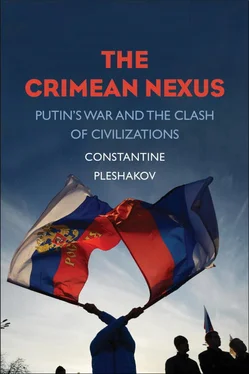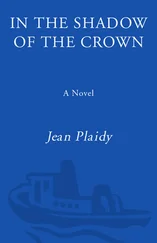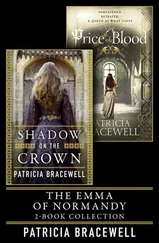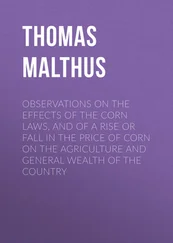But according to Russian Orthodoxy, Sevastopol is sacred grounds twice over. In 988, Prince Vladimir, the ruler of Kievan Rus’, converted to Christianity in Chersonesus; returning to Kiev, he made Orthodoxy the state religion—as tradition says, converting the rest of the country “by sword and fire.” [40] Luttwak, The Grand Strategy , 121–122; Milner, The Crimea , 116.
In the mid–nineteenth century, local clergy tried making Crimea a “Russian Athos,” intending to steal the clout of the original Mount Athos, an autonomous theocracy on the Chalkidiki Peninsula in northern Greece, which had traditionally been the center of Eastern Orthodox mysticism. Crimea’s South Shore resembled the Holy Mountain in looks; some Christian sites on the peninsula were old; Christians and Muslims alike venerated a number of locales for their alleged paranormal qualities.
To that purpose, several monasteries got fixed or built—St. George’s near Balaklava, Dormition in Bakhchisaray, Inkerman off Sevastopol, Cosmas’ and Damian’s deep in the mountains. For several years, the rebranding seemed to work, attracting Orthodox pilgrims. What unexpectedly killed the project was technological progress: steamships allowed a pilgrim to reach the real Athos from any Black Sea port in only two or three days. [41] Kozelsky, Christianizing Crimea , 78–117.
One can’t tell the story of the Crimean War or World War II without Sevastopol. But take out the Russian Black Sea Fleet, and nothing in the bigger picture changes. Here we come to one of the many paradoxes of Russian history: although it is a staple of Russian state mythology, and a powerful presence in literature, art, and politics, the Russian navy has very little to boast of in terms of battles won and enemy fleets destroyed. To this day, its biggest feat remains its tragic journey around Europe, Africa, and Asia in 1904–1905 to the Sea of Japan, where it was decimated by the Japanese navy in the infamous Battle of Tsushima. [42] Constantine Pleshakov, The Tsar’s Last Armada: The Epic Journey to the Battle of Tsushima (New York: Basic, 2000).
The navy is the “favorite child of Peter the Great,” because he built it from scratch, first by learning for himself how to build warships on the wharfs of Holland and England. The new capital, St. Petersburg, was conceived as a glorified base for his favorite child. Yet despite all the effort, cost, sweat, and blood spilled, the Russian navy remained more a meme than a real thing, more romantic than sensible, more patriotic than practical.
Russia’s geographical limits make a big navy an expensive toy: few warm-water ports, too many inner seas, and a total inability to move a fleet quickly from one theater to another. A winning weapon for Russia is aircraft and missile, not cruiser and submarine.
The folly is particularly apparent in the south. The Sea of Azov, the Black Sea, and the Mediterranean are like three nesting dolls. An unfriendly force can lock each one of them shut—the Sea of Azov at the Strait of Kerch, the Black Sea at the Bosporus and the Dardanelles, the Mediterranean at Gibraltar. Short of an unimaginable collapse of the West, there is no geostrategic situation that could give the Russian Black Sea Navy unhindered access to the Atlantic.
During the Crimean War, the Russian fleet, blockaded in Sevastopol by the British and the French, became a heroic sitting duck. The Russians ended up scuttling their ships to prevent the Allies from moving into the harbor. In 1918, to keep Germans from capturing it, Russians scuttled the fleet in Novorossiysk. In 1942, abandoning Sevastopol, the Soviets scuttled the fleet again. One could say that the Russian Black Sea Fleet kills itself with shocking readiness: suicide may be its most effective tactic. The Monument to the Scuttled Ships at the entrance to Sevastopol harbor, a tasteless column awkwardly stuck into a pyramid of rocks, has been a symbol of the city since 1905. The bronze eagle on top, crowning the column with a laurel wreath, looks eternally perplexed, as if it were not sure what exactly the monument celebrates.
The admirals who presided over the defense of Sevastopol in 1853–1856, Vladimir Kornilov, Pavel Nakhimov, and Vladimir Istomin, all killed during the siege and buried in the Admirals’ Vault in St. Vladimir Cathedral in Sevastopol, entered the pantheon of Russian military geniuses. At least five Russian ships have borne Nakhimov’s name. In 1944, Joseph Stalin established the Nakhimov Medal for sailors, the Nakhimov Order for officers, and Nakhimov schools for young cadets.
As a fetish, Crimea appeals to every ideological camp. Members of the liberal intelligentsia are attracted to Chekhov, Koktebel, and Brodsky, while the far right, despising Koktebel as decadent, idolizes Sevastopol and the Black Sea Fleet.
As Russia’s fixation focuses on Crimea as an assemblage of inanimate objects (relics of the past; urban structures; rock, sea, beach) and memories (people and narratives), the agency of the actual people living on the peninsula fades to the background. In Russian eyes, the peninsula has little function except as an object of desire. The Tatars’ legacy and current strife are ignored, Ukraine’s are ridiculed, and the Crimean Russophiles are seen only as hostages Russia had to rescue.
The native Crimean cast of the 2014 crisis is usually described as Russians, Ukrainians, and Tatars, as if national identities were as distinct as military insignia, superseding generation and class. No matter how you define “ethnicity” (“language,” “blood,” “tradition”), it alone could never have determined how Crimeans reasoned and acted during the crisis. No cultural group on the peninsula was monolithic.
The pending change on the peninsula jeopardized the rights and privileges of some and promised to expand them for others. Russia was not exactly an unknown quantity; on the peninsula, it had a presence, a reputation, and a history. Similarly, Ukraine, which was on the way to losing Crimea, was not a paragon of peace and prosperity. Wages in Ukrainian Crimea were among the lowest in Europe: they averaged $300 a month, versus $700 in the rest of Ukraine, $1,200 in Russia, and $1,500 in Poland. In theory, at least, Crimea was moving from a poorer community to a richer one in becoming part of Russia, with higher living standards, more jobs, and more upward mobility. [1] “Chto takoe Krym: tsifry i fakty,” Allcrimea.net, March 8, 2014, http://news.allcrimea.net/news/2014/3/8/chto-takoe-krym-tsifry-i-fakty-6949 (retrieved November 11, 2014).
For Crimean Russophiles, a group containing many ethnic and cultural backgrounds, reunification with Russia had been a priority for twenty years. In 1994, a democratically elected president of Crimea, Yury Meshkov, actually attempted secession, but Yeltsin’s Kremlin brushed him off; the Russian economy at the time was in shambles, Yeltsin needed U.S. aid, and he did not want to jeopardize his good standing with President Clinton. Also, Moscow was fighting a war in Chechnya and had neither the resources nor the willpower for a conflict with Ukraine. [2] Matlock, Autopsy of an Empire , 701–702.
Nationalist ideologues and populist politicians in mainland Russia, meanwhile, never gave up their claims on Crimea and the “City of Russian Glory.” Unspecified but not insignificant sums of private money fed Russophile cultural and political nongovernmental organizations on the peninsula. An American visitor to the city in the 1990s noted “its passionate Russian-ness, its stunned refusal to acknowledge the collapse of the Soviet Union.” Local newspapers were called Glory to Sevastopol and The Motherland Flag . [3] Anna Reid, Borderland: A Journey Through the History of Ukraine (Boulder, Colo.: Westview, 2000), 171–173.
Читать дальше












